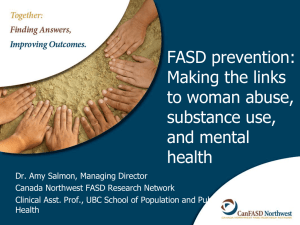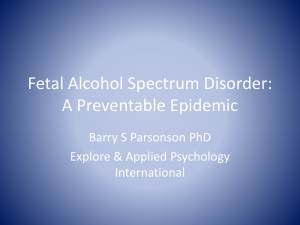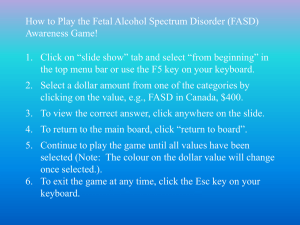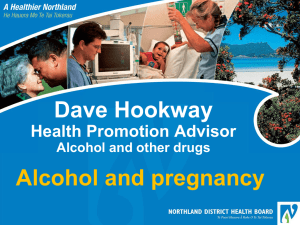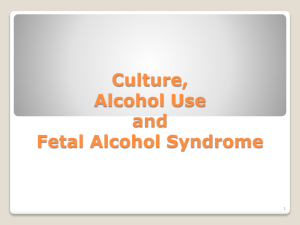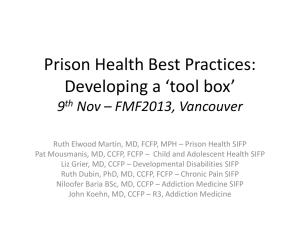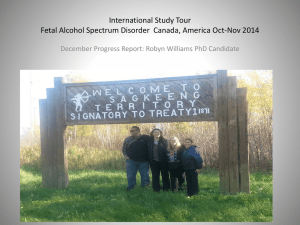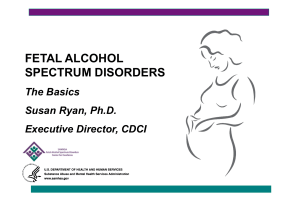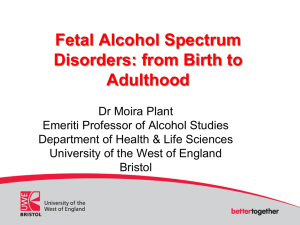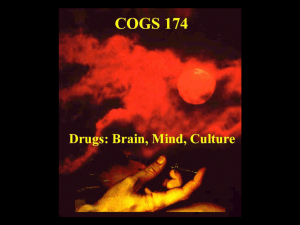Fetal Alcohol Spectrum Disorder
advertisement
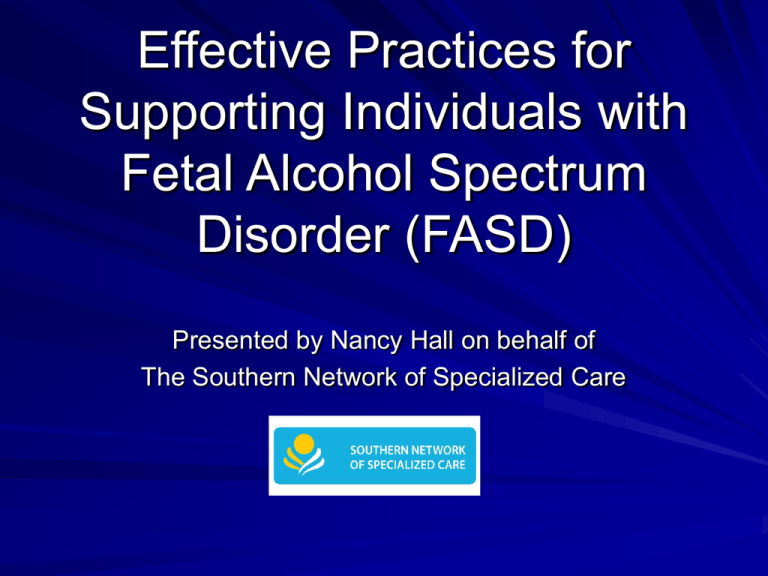
Effective Practices for Supporting Individuals with Fetal Alcohol Spectrum Disorder (FASD) Presented by Nancy Hall on behalf of The Southern Network of Specialized Care Presenter Information • Currently, Facilitator for The Southern Network of • • • • Specialized Care Previously, FASD Community Development Facilitator representing 29 service delivery agencies, doctors and parents working in the Hamilton, Burlington, Niagara and H/N communities Worked in social services for over 20 years as program manager supporting individuals with physical, developmental and mental health issues Specializing in behavioural consultation and intervention Member of the FASD Ontario Network of Expertise Towards a Provincial Strategy Advancing Effective Service Provider Practices in Fetal Alcohol Spectrum Disorder (FASD) 2010 Intervention and Support Working Group The information presented here is, primarily, the results of a research paper produced by the Support and Intervention Working Group of the FASD Ontario Network of Expertise (FASD ONE) See www.fasdontario.ca to find this document, as well as documents dedicated to Respite Needs and Education. Advancing Effective Service Provider Practices in Ontario Goals: • To determine what practices are most effective with individuals affected by FASD- resulted in a review of existing resources/literature • To determine if service providers in Ontario are using these practices- survey of the parents/caregivers of children with FASD in Ontario Results • Eight primary effective practices were identified as critical in the successful support of this population; -Emphasis on early diagnosis -Training and education in FASD -A paradigm shift to a positive, strength-based approach -Structure, routine and supervision -Effective communication approaches -Awareness of and supports for Sensory Processing Disorders -Collaborative services -The need for life-long interdependent supports • 30 service providers in Ontario were identified as effective and all 30 confirmed their consistent support and/or use of these eight practices Acknowledgements • Stephanie Jones, co-author of the booklet • • • • “Strategies Not Solutions”. Stephanie has acted as a case consultant and has been training professionals in both FASD and successful intervention techniques since 2002 Ann Streissguth, 1997 Dan Dubovsky from SAMHSA FASD Center for Excellence, Rockville MD Nathan Ory, M.A. Diane Malbin, MSW from FASCETS, Portland, Oregon Fetal Alcohol Spectrum Disorder (FASD) FASD is an umbrella term referring to a range of disabilities resulting from prenatal exposure to alcohol. This includes: FAS- Fetal Alcohol Syndrome- all three facial features, neurological damage pFAS- Partial Fetal Alcohol Syndrome- 2 out of 3 features, neurological damage ARND- Alcohol Related Neurodevelopmental Disorder- no facial features, neurological damage FAS – only the tip of the iceberg FAS & pFAS> Collectively represent approx. 15% of those affected ARND>Represents 85+% of those affectedmost will go unrecognized Current research tells us that at least 1 out of every 100 people is affected by prenatal exposure to alcoholthis is permanent brain damage FASD: Impact on the Individual “Of all the substances of abuse (including marijuana, cocaine and heroin), alcohol produces, by far, the most serious neurobehavioural effects to the fetus” -IOM Report to Congress, 1996 FASD is the leading cause of disability and with 10% also having a developmental delay, it is also the leading cause of developmental delay. FASD Behavioural ProfileReflects Poor Executive and Adaptive Functioning Inconsistent performance Poor regulation of emotionacts immature Poor memory-erratic (esp. short-term) Lack of abstract reasoning Failure to predict Do not understand cause and effect Fails to generalize Tendency to be oppositional or boastful with figures of authority Poor self-monitoring Poor sense of self Strong verbal expression Poor receptive language Short attention spanerratic/impulsive Difficulty with time concepts Difficulty with transitions Appears unmotivated/ lazy (cannot ‘walk the talk’) or manipulative Sensory sensitivities very prevalent- watch the environment Secondary Disabilities Mental health problems-*research may redefine this as a primary disability with 95% affected also having MH problems Disrupted school experiences (68%) Confined in prison/treatment centre (55%) Trouble with the law (68%) Inappropriate sexual behaviour (52%) Alcohol and drug problems (30-35%) Problems with employment (70%) and living independently (82%) Effective Intervention and Support Diagnosis • Diagnosis is critical for Effective Intervention • Research indicates that prognosis is best with diagnosis before the age of six • Accurate diagnosis assists caregivers to understand the disability and adjust intervention strategies- Typical behavioural supports tend to be ineffective • Appropriate support and understanding acts as a protective factor against secondary disabilities Diagnosis (cont.) • To reduce unrealistic expectations-look more • • • • capable Allows for life long planning for supports This information may result in the prevention of other affected children (education, monitoring and support for mom) Using a pre-screening tool to identify those potentially affected or “thinking FASD first…” in the absence of diagnostic services will reduce the occurrences of damage to the child through inappropriate interventions Early recognition allows for better outcomes for both the individual and their family Comparing FASD, ADHD and Oppositional Defiant Disorder Dan Dubovsky, 2008 FASD ADHD Oppositional Defiant Disorder Do not complete tasks Do not complete tasks Do not complete tasks -may or may not take in information -cannot recall information when needed -cannot remember what to do -takes in information -can recall information when needed -get distracted Provide one direction at Limit stimuli and a time provide cues -takes in information -can recall information when needed -choose not to do what they are told Provide positive sense of control; limits and consequences Beliefs Dictate Interventions Behaviours are willful =Punish Behaviours are symptoms =Support *Education and Training in FASD is critical to this understanding! Behaviors, Misconceptions and Accurate Interpretation Behaviours Misconception Accurate Interpretation Noncompliance Willful misconduct, attention seeking, stubborn, everyone does this at times Difficulty translating verbal direction into action, doesn’t understand, chronic memory problems Repeatedly making the same mistakes Willful misconduct, manipulative Cannot link cause to effect, can’t see similarities, difficulty generalizing Often late or doesn’t attend appointments at all Lazy, slow, willful misconduct, lots of people are late Can’t understand the abstract concept of time, needs assistance organizing, needs ongoing support and reminding Behaviors Misconceptions and Accurate Interpretation Behaviours Misconceptions Accurate Interpretation Not sitting still/fidgeting Seeking attention, bothering others, willful misconduct, normal for this age Neurologically based need to move while learning/listening, sensory overload Poor social judgment Poor parenting, willful misconduct, neglected/abusive childhood Unable to interpret social cues from peers/others, can’t control impulses Overly physical Willful misconduct, deviancy Hyper or hypo-sensitive to touch & environment, can't understand social cues regarding boundaries Why Education and Training? There is a prevalent lack of knowledge of FASD and its effects in both the general public and the medical field In addition to the problem of no diagnosis we see high rates of misdiagnosis Diagnosis is not enough…we must then understand the affects of FASD and what supports will result in success- typical behavioural approaches are not usually successful Education of professionals is equally important to the education of family and of the individual themselves Paradigm Shifts- Changing understanding From Seeing Person as: -Won’t -Bad -Lazy -Lies -Doesn’t Try -Mean -Doesn’t Care, shuts down -IS a problem -Acts Immature To understanding Person as: -Can’t -Frustrated, challenged -Tried Hard -Confabulates/ fills in -Exhausted/ can’t start -Defensive, hurt, abused -Cannot show feelings -HAS a problem -Is dysmature Changing What we Do From: To: -Assuming -Observing -Preventing Problems -Appropriate Expectations -Success -Changing Environments -Trying Differently -Punishing -High Expectations -Failure -Changing People -Trying Harder Paradigm Shift • UNABLE not unwilling to understand consequences • “We must move from viewing the individual as failing if s/he does not do well in a program to viewing the program as not providing what the individual needs in order to succeed.” Dubovsky 2000 • We are changing what WE do, not the person • “If they could get it for themselves, they wouldn’t need us!” Dubovsky 2007 The Big Picture- Paradigm Shift We know they aren’t doing it on purpose and they cannot understand consequences, so now what?? • Get Curious: When you seek to change the individual, ask yourself what is it that you also need to change. • Notice your own reactions • Catch yourself assuming • Observe disruptions in routine • Look at the environment Think Can’t not Won’t- How Do We Adapt? FASD looks like… What How we What The Rewe feel we do… Results frame want… about our and it… reaction Prevent Rigid, Stop when perseverates told, no , difficulty resistance stopping/ changing activities He/she is controlling oppositional and bossy Interrupt, assert control, require transition Resistance, Anger, BIG Tantrum Adjust workload to achieve closure, give time Sensory issues- over stimulated, over whelmed, distractable He/she is not trying, undisciplined off task, ADD, Irritated, Anger Punish, more work, medicate, no recess Agitation, anger, avoidance, anxiety, tantrums Evaluate the environment, reduce stimulation, provide breaks Pay attention, Sit still, ignore distractions Start with Seeing Success • Attendance is success • Not having secondary disabilities is success • Having a good day is more important than completing all assignments • Learning how to self monitor and self regulate is just as important as learning math • Giving the words is not giving the answers • If he is successful in 1 class than why push for more? Positive Strength Based Approach Assessment includes determining strengths and weaknesses Includes; -what they do well? -what do they like? -what are their best qualities? -what do you like about them? A good program should have a ‘no eject’ policy because of brain based behaviour Using a Strength Based Approach Effective programs understand behaviors are the result of permanent brain damage- it is not see as willful A positive approach; - moves from punishment to understanding and changing the environment or expectations -moves from trying to change symptoms to changing our reactions -has no negative carry-over from one day to the next -the inventory of strengths includes family and service provider strengths to determine strong supports -positive/strength based activities are never used as a treat or punishment resulting from good or bad behaviour Strengths of People with FASD trusting don't give up easily caring friendly artistic musical great speakers creative working with hands “Find something that the person does well (that is safe and legal) and arrange to have the person do that regardless of behaviour” A Positive Outcome Means Talking about FASD • Talk about FASD – no shame • FASD is a disability • The ability to express their challenges and strengths will help them advocate for themselves in adulthood Structure Supervision Support • Supervision is an absolute MUST. All the time• • • • type/intensity dependent on functional level. Structure keeps the person anchored in time and reduces anxiety. Helps them think less-anticipate/predict more Means doing the same thing, in the same order, in the same manner (with the same cues and prompts) and with the same expectations. These are the rules. Make a plan of things he is good at/enjoys- for activities when there is none Structure Supervision Support • Support means modeling, cueing, prompting and getting everyone on board with it. • What is modeling? -Think Aloud-give key self talk phrases -Follow through -Write out pro / con lists -Make the connection again later when they are ready Support (continued) Focus on what they can do; ensure expectations are within their capacity. -If they fail to follow through on a task, shows signs of anxiety or frustration, some form of accommodation is required -Consider inconsistent performance on tasks Step in early to prevent escalation of problems -Poor problem solving skills means they have limited capacity to adapt their responses -Brain impairment means they cannot selfcorrect and will repeat mistakes (perseverate) Structure Supervision Support If there is Going to be a Change • “I have an announcement, there is going to be a change. Sometimes that happens but I’m not going to have a big hairy fit about it.” • Show them what the expected behaviour looks like. • If time, change the calendar, write a post-it note. Organize for them. Repeat after me: Prevention (Overall) • lock up your purse, cupboards and fridge. Colour code her things. Sew up/rip up pockets. Ask “Should we search your pockets?” • Be their external brain. If you know something bad is going to happen if…. Don’t let it happen. • Be ready. A birthday + long weekend + sharing your attention = disaster Memory Strategies • Keep your routine!!! “Tacos on Tuesdays” “House cleaning on Saturdays” • Colour-code to a calendar or day timer • Schedule in locker • Post lists, charts, pictures- visual cues • Review, reteach, remind • “Give gentle reminders rather than nags and then watch him like a hawk” faslink Communication Supports • Individuals with FASD tend to be very verbal with little content. • Receptive language is more impaired than expressive. This presents as a larger problem when we consider that successful outcomes are reliant on receptive language in many situations. Including; -parenting techniques -education -justice system and -treatment (motivational interviewing, cognitive behavioural therapy, group therapy and AA/NA groups) Dubovsky, 2008. • Consider the total communication approach. Pairing words with pictures, photos, gestures and signs. Communication Supports • Match your language to that of the level of the • • • • • • • person. Consider variations depending emotional state. Use eye contact and exact repetition 10 words or less, simple and clear Come to the end of the thought and wait a few seconds Avoid giving instructions in places where you can’t control the environment (the mall) Body/facial expression exaggerated State directions in positive terms (what they can do vs what they cannot do) Check for concrete understanding Communication Supports (cont.) • Refrain from the use of sarcasm and ensure • • • • individual has jokes explained to reduce misunderstanding and conflict-concrete Always refer to persons in a group not ‘they’ or ‘them’- be concrete Link one task to another to establish sequences i.e. the bus comes after breakfast Use sign language if possible Be careful with abstract words (‘get ready’) or generalize (‘watch’) Abstract Language • Why?, Wait, Watch, Listen • Get ready, Clean up • Join, Get in line • Respond, Choose • Be responsible/appropriate • Do it later, Wait • Use your words, Ask for help • What are you feeling? • “When you’re done, take a cab home.” Visual Cues Visual cues can be used to reduce the amount of verbal communication required. It can be used to communicate; • Physical Boundaries • Rules • Personal Routines • Schedules • Anger Management Plans • Etc. Pictorial Cueing Pictorial/Visual Cueing • When can we stop using cueing? • When can we stop using pictures? Sample….. Communicating a Transition • Routine and Structure • Pictures on hand (wall, wallet, desk) • A Gesture • Marking on floors • Visual clock • Watch alarm • Other concrete object Sensory Integration Dysfunction Individuals with SID have difficulty processing and interpreting sensory information resulting in over or under-stimulation and behaviours. Defensiveness: Includes impulsivity, self injury/aggression, avoid contact, picky eater, wears same or inside out clothing, dislikes face washing, hair brushing etc. Modulation: Includes distractibility, activity level extremes, difficulty with transitions and low tolerance levels Sensory Integration Dysfunction (cont.) Registration: Includes acute awareness of noise/lights/sound/smells, lowered awareness of pain and temperature, tip toe walking, poor body awareness Integration: Includes hand preference delayed, poor eyehand co-ordination and problems with motor planning (may have apraxia) **OT identification is vitally important as often behaviours are seen in all 4 areas with children affected Sensory Integration Dysfunction Behaviours resulting from SID should cue us to determine the cause for behaviours rather than targeting the behaviour itself. To reduce the effects of SID it is important to Modify the Environment. This will; -Reduce Over Stimulation -Increase ability to attend -Increase prediction and ease of transition with posted schedules -Increase ability to self-regulate with boundaries identified and prepared ‘comfy corners’ Possible Environmental Modifications • Pale/ soft colours • Bookshelves turned so all information is not ‘in your face’ • Limit number of pictures • Reduce smells/ sounds in the environment (tennis balls on chair legs) • Minimalist environment-less knick-knacks, less furniture, less choices **When unsure what will help…ASK! Think About His/Her Home and Other Environments • Seating-exercise ball, rocking chair, bean • • • • bag chair Lighting-go natural, watch the glare, lava lamps Visual Stimulation-de-clutter, muted colours Calming tools-fidget toys, lap blankets, bubble wrap, weighted backpack. Organizing-big calendar, gum Comfy Corner/Quiet Area What is it? A space that has objects to decrease the feeling of being overwhelmed or over-stimulated Why is it Important? The person affected may not be able to vocalize the feeling of getting over- stimulated and suddenly there is a behaviour. They need to learn what activities calm them and practice them to develop life long skills in self monitoring and self regulation Comfy Corner Ideas Reading cabin made out of washing machine box A closet A tent Tarp lean Bookcase without shelves secured to the wall Sunglasses, headphones and a hoodie Sensory Diet What is it? • A balance of sensory feedback activities • Includes a combination of alerting, organizing and calming activities Why? • Affected individuals often can’t feel when they are getting wound up or lethargic or just right. • Teaches them how to recognize where their engines are at and how to keep feeling just right. When? • Often throughout the day (consider time of day- after school, before test or other stressful activity) • Eventually, they will ask for it (keep items on hand when leaving home) Sensory Diet Ideas Alerting • Crunching dry cereal, popcorn, chips, crackers, nuts, pretzels, etc. • Taking a shower Organizing • Chewing on gum, granola bar, bread crusts, bagels, licorice, dried fruit, etc. • Pushing or pulling heavy loads Sensory Diet Ideas Calming • Sucking on a hard candy, frozen fruit bar • Pushing against walls with hands, shoulders, back, butt, head • Back rubbing • Taking a bath. Sensory Ideas • Adults may be more subtle but still in need of sensory integration. • A firm hand on shoulder with medium pressure • Need to go to a quiet place to think • Needs many smokes to calm down • Needs sun glasses while in the car • Loves to push, pull, lift heavy loads • Likes to wear heavy work coat and hat • Let adults guide you to what they need A Focus on Collaborative Services FASD is complex and often requires a variety of different support services “Agencies working together synergistically tend to increase the effectiveness of services provided to clients with FASD” Dubovsky, 2007 Case managers can survey all service provider supports, coordinate the services, arrange for collaborative planning and the modification of supports through education Life Long Interdependent Support Brain impairment is life long. There is consensus among experts that individuals with FASD are unable to stay organized or focused and are easily influenced by others. There is a limited capacity to exercise good judgment, anticipate consequences and stay safe. Therefore, they will need long term external structure, support and supervision- an external brain or brains Dealing with Resistance ~ Building the Relationship Letting it be their idea “Maneuvering” for Success Resistive Behaviour Has Many Roots • “Problems translating verbal directions into action” “I’d rather look bad than stupid” • Overly stimulated “I can’t take it anymore” • Unresolved grief and loss issue related to time of year “My birth mother gave Allan Mountford me up on my birthday” Bill Dubovsky • Patterned behaviour with authority (sarcasm) tit for tat constantly • Negative Blueprint “I’m always in survival mode even when you show me you care about me” Overcoming Resistive Behaviour by Letting It Be Their Idea ~ Nathon Ory www.fasdconnections.ca • Remember that normal teen issues are: a. feel in control b. feel independent from authority • Goal: Give the person the idea of what he or she would actually wish to do • 1st: Get the idea in their mind • Create “accidents” that will cue the person to do the desired behaviour • Then: Agree with them by going in their direction. Maneuvering the Environment for Success Creating an optimal environment for compliance, self-confidence and success. Do: What you are comfortable with What it takes to get others on board Have one lead person Don’t: Let others convince you that the truth is best Let others convince you that she has to know everything Maneuvering the Environment for Success - Examples Setting up his first apartment and/or job • Check it out first, have her drop by spur of the moment. • Make safety issues part of the lease/contract. • Get others saying the same thing (bus drivers, cleaning staff, landlords, etc.) • Let them think… “Yes, of course you will….” • Remember it’s like you are dealing with a youth with Alzheimer's Time • Visual timer, ticking timer or time timer • Be careful when you say 2 o’clock. It could mean 2:01 to 2:59 • Use charts to link time and activities I.e. clocks, words, activity (bathroom chart) • Give adults in SIL a watch that can be programmed to go off at curfew • Gadgets that have hourly chimes or pill containers that can be set for up to 5 alarms (Circuit City) Money • Teach money association to objects • Point out good spending decisions • Create a learning savings in class and keep track on a white board, where appropriate • Before going in to the store, talk about what’s going to happen, make a list and stick to it! • Stay on top of important purchases with care givers. If the buying day is coming, keep reminding her of the expectation. • Always give a ticket rather than money • Never give a credit card or gas card-make up a reason why you can’t have one either • Own up to your mistakes. Think aloud. • Get a Power of Attorney Life Skills • Make one day a week cleaning day and don’t change it! • Have instructional pictures on machines • Make a shopping list and go at low times • Buy food mixes that have pictures • Use the microwave when ever possible • Pictures or words for all shelving and cupboards Self Care/Hygiene • Create Bathroom charts with pictures of clocks • • • • and matched activity for morning routines Practice shaving with a razor, putting on a condom Encourage practicing for feminine hygiene Use egg timer for teeth brushing Teach/model how to use soap, shampoo, toothpaste- don’t assume they know how. Check regularly to see if they have forgotten Rages • Poor emotional control 0-100 in 3 seconds • Frequently does not understand social cues until it is too late • Unable to verbalize the issue in the moment ----------------------------------------------------------• Prevent it. Low stimulation, lots of breaks • Be gentle and direct when it is escalating • Coach others not to engage or push back during a rage • When it is over make apologies and move on • Later review calming strategies for next time. Confabulation • • • • If I think it, it must be true I hope this is what happened I don’t want to get into trouble so… Perception is complicated by long-term memory problems • He must persist in the story no matter what ----------------------------------------------------------• Do not confront a minor lie (exaggeration) • Be gentle but firm. “I am mandated to call___ whenever there is confusion about and event. We need to get this issue cleared up”. • Teach the moral lesson much later- no punishment Stealing • If no one is around it, it is not owned by anyone • Finders Keepers • I see other people doing this • I NEED this ___ to survive ----------------------------------------------------------• Prevent it. Label all her things • Ask “Do you need to show me your pockets?” • Have her dump out her backpack • Gently point out what is not hers • Give back immediately • Give the lesson later- not about punishment Accommodations FASD is an invisible physical disability Brain structure and function is changed Behaviours are symptoms Trying harder to change behaviours makes things worse 5. Recognizing the disability and providing accommodations prevents problems 6. This is what we do with people with visible disabilities 7. It works 1. 2. 3. 4. The Southern Network of Specialized Careservices for individuals with Purpose: To promote and enhance developmental disabilities who need specialized care for coexisting mental health issues and/or significant behaviours (Dual Diagnosis) 1. 2. 3. 4. 5. 6. 7. Develop & Promote Relationships Across All Sectors Develop Specialized Clinical Skills & Services Education Research Recruitment & Retention Data – Gap Identification Unified Community Voice For more information contact Nancy Hall at nhall@bethesdaservices.com or 905-684-6918 X312 Resources • Edmonton and Area Fetal Alcohol Network. (2004). FASD strategies not solutions. Published by The Government of Alberta Children’s Services. www.region6fasd.ca • Graefe, Sara. (2006). Living with FASD: A guide for parents. Vancouver: Groundwork Press. • Kranowitz, Carol. (1998). The out-of-sync child: Recognizing and coping with sensory integration disorder. New York: Skylight Press. • Malbin, Diane. (2002). Trying differently rather than harder. FASCETS, Portland, Oregon. Resources (cont.) • Streissguth, Ann. (1997). Fetal alcohol syndrome: A guide for parents and families. Baltimore: Brookes Publishing. • Streissguth, A., & Kanter, J. (1997). The challenge of fetal alcohol syndrome: Overcoming secondary disabilities. Seattle, WA: University of Washington Press. • Trudeau, Debbie (Ed.). Fetal Alcohol Syndrome Society Yukon. (2002). Trying differently. A guide for daily living and working with FAS and other brain differences. 2nd Edition. Resources recommended by Ontario Service Providers • "Once Upon a Time: Therapeutic Stories that Teach and Heal" and "Once Upon a Time: Therapeutic Stories to Heal Abused Children (revised edition) by Nancy Davis PhD. Saskatchewan FASD Tip Sheets www/skfasnetwork.ca • http://www.skfasnetwork.ca/Network%20Resources%20&%20Materials.h tml • http://www.come-over.to/FAS/faslinks.htm Best FASD Sites • Fetal Alcohol Spectrum Disorder, by Toronto FASD Coordinating Network 2008 • http://www.torontocas.ca/wp-content/uploads/2008/09/FASD.pdf • Strategies Parents find Helpful in Raising Children Living with FASD, prepared by Czaee Rajwani. Toronto: St. Michael’s Fetal Alcohol Spectrum Disorder Clinic, 2007. Resources recommended by Ontario Service Providers (cont) • http://come- over.to/FAS/PDF/TorontoStrategiesParents.pdf • FASlink Discussion Forum is an Internet mail list for individuals, families and professionals who work with FASD. This provides support and information 24/7. To join FASlink go to http://listserv.rivernet.net/mailman/listinfo/fas-link • Olderfas is a support group and discussion list for parents only. They welcome family members/parents/caregivers supporting for older teens with FASD who are transitioning to adulthood. Diagnosis is not required. To join go to http://groups.yahoo.com/group/Olderfas/ • Picture This: Life as a Parent of Children with FASD (podcast): http://citizenshift.org/picture-this
